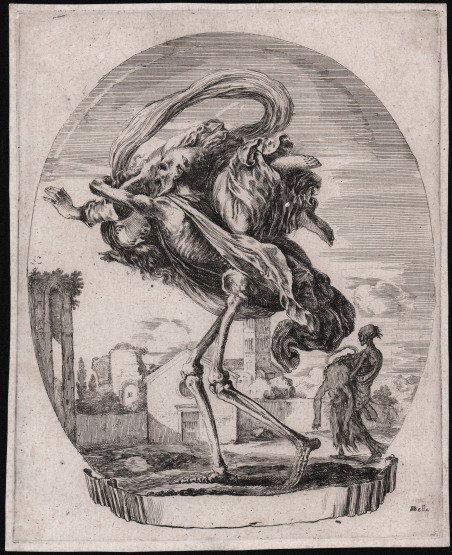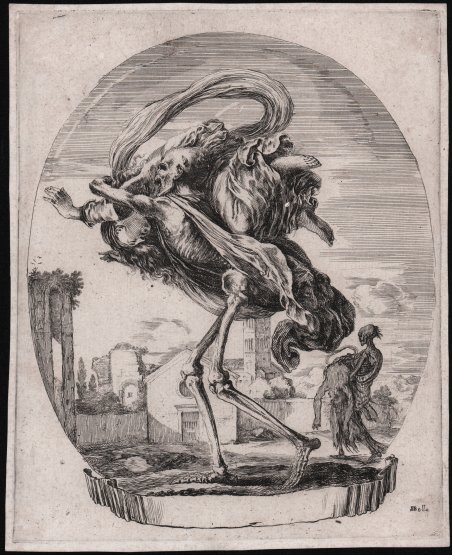Acquaforte e bulino, circa 1647, firmata in basso a destra SDBella. Esemplare nel terzo stato di quattro, completato al bulino e avanti l’indirizzo dell’editore Vincent in basso. Bellissima prova, impressa su carta vergata coeva, completa oltre la linea del rame, con margini bianchi di circa 4mm per lato, in ottimo stato di conservazione Della serie “Le cinque Morti – Les Cinq Morts”, che l’autore completa in Francia. Fu probabilmente durante i suoi ultimi anni in Francia che Della Bella iniziò una versione aggiornata della Danza della Morte. Questo soggetto tipicamente nordico e medievale di solito mostrava la Morte in una varietà di situazioni, portando via vittime di ogni età ed estrazione sociale. Mentre era in Francia Della Bella incise quattro scene ovali della conquista della Morte, compresa questa stampa (La Morte che porta un bambino), tre delle quali si svolgono nei cimiteri e la quarta sul campo di battaglia. Una versione orizzontale della Morte che trionfa in guerra risale probabilmente a questi anni. Alla fine della sua vita, Della Bella riprese il tema, creando altri tre episodi nel formato ovale, due dei quali rimasero incompleti alla sua morte. Soprattutto nelle prime stampe, la Morte è tanto energica quanto spietata: qui la Morte porta sulle spalle una donna con la testa rivolta verso il basso, seguita a distanza da un'altra Morte che tiene in braccio un cadavere. L'ambientazione è il Cimitero degli Innocenti a Parigi, un luogo che della Bella conosceva senza dubbio, dato che molti editori e commercianti di stampe avevano i loro negozi al piano terra degli ossari. Stefano della Bella fu uno degli incisori più interessanti e originali nella Firenze del XVII secolo e può considerarsi l’unico geniale continuatore dell’opera di Jacques Callot. La sua educazione artistica ebbe inizio a Firenze nella bottega degli orafi Gasparo Mola e Orazio Vanni, e la precisione del segno, tipica dell’arte orafa resterà caratteristica del suo stile. Studiò poi presso Giovanni Battista Vanni e forse anche presso il Cantagallina e Cesare Dandini, ma ben presto si dedicò all'incisione. Il suo vero maestro può considerarsi Jacques Callot, l’incisore francese che soggiornò a lungo a Firenze lasciando una forte impronta nel panorama artistico della città. Gli anni più importanti della sua carriera sono quelli che trascorre a Parigi, dal 1639 al 1650, stipendiato da Lorenzo de' Medici: lavorò insieme ad Israel Silvestre, con gli editori Langlois, Ciartres e Pierre Mariette, per stampatori francesi e per commissioni di gran prestigio, come quelle del 1641 per il cardinale Richelieu che gli affidò le illustrazioni delle sue imprese guerresche. Intorno al 1647, durante un viaggio in Olanda, dove eseguì le acqueforti con le vedute del porto di Amsterdam, incontrò Rembrandt e da quella data notiamo una eco profonda dell’arte dell’olandese nella grafica del Della Bella. Bibliografia De Vesme – Massar, n. 90, III/IV. //// Example of third state, of four, before the Vincent publisher address. Magnificent example, printed on contemporary laid paper, white margins of 4 mm ca. for each side, excellent condition. From the series The Five Deaths- Les Cinq Morts, which Della Bella completed in France. It was probably during his last years in France that Della Bella began an updated version of the Dance of Death. This typically Northern and medieval subject usually showed Death in a variety of situations, carrying away victims of every age and walk of life. While in France Della Bella etched four oval scenes of Death's conquest, including this print (Death Carrying a Child), three of which take place in cemeteries and the fourth on the battlefield. A horizontal version of Death triumphing in war probably also dates to these years. At the end of his life, Della Bella took up the theme again, creating three more episodes in the oval format—two of these were left incomplete at his death. In the early prints particularly, Death is as energetic as he is ruthless—here Death carrying off a female on his shoulders, with her head downwards, followed at a distance by another Death holding a corpse in his arms. The setting is the Cemetery of the Innocents in Paris, a site with which della Bella was undoubtedly familiar, since many publishers and print dealers had their shops on the ground floor of the charnel houses. Stefano della Bella was one of the most interesting and original engravers in 17th-century Florence and can be considered the only brilliant continuator of Jacques Callot's work. His artistic education began in Florence in the workshop of the goldsmiths Gasparo Mola and Orazio Vanni, and the precision of sign, typical of the goldsmith's art, will remain characteristic of his style. He then studied under Giovanni Battista Vanni and perhaps also under Cantagallina and Cesare Dandini, but soon turned to engraving. His real master can be considered Jacques Callot, the French engraver who stayed in Florence for a long time and left a strong imprint on the city's artistic scene. The most important years of his career were the ones he spent in Paris, from 1639 to 1650, salaried by Lorenzo de' Medici: he worked together with Israel Silvestre, with the publishers Langlois, Ciartres and Pierre Mariette, for French printers and for commissions of great prestige, such as those of 1641 for Cardinal Richelieu, who entrusted him with illustrations of his warlike exploits. Around 1647, during a trip to Holland, where he executed etchings with views of the port of Amsterdam, he met Rembrandt, and from that date we note a profound echo of the Dutchman's art in Della Bella's graphic work. Bibliografia De Vesme – Massar, n. 90, III/IV.


Scopri come utilizzare
Scopri come utilizzare
